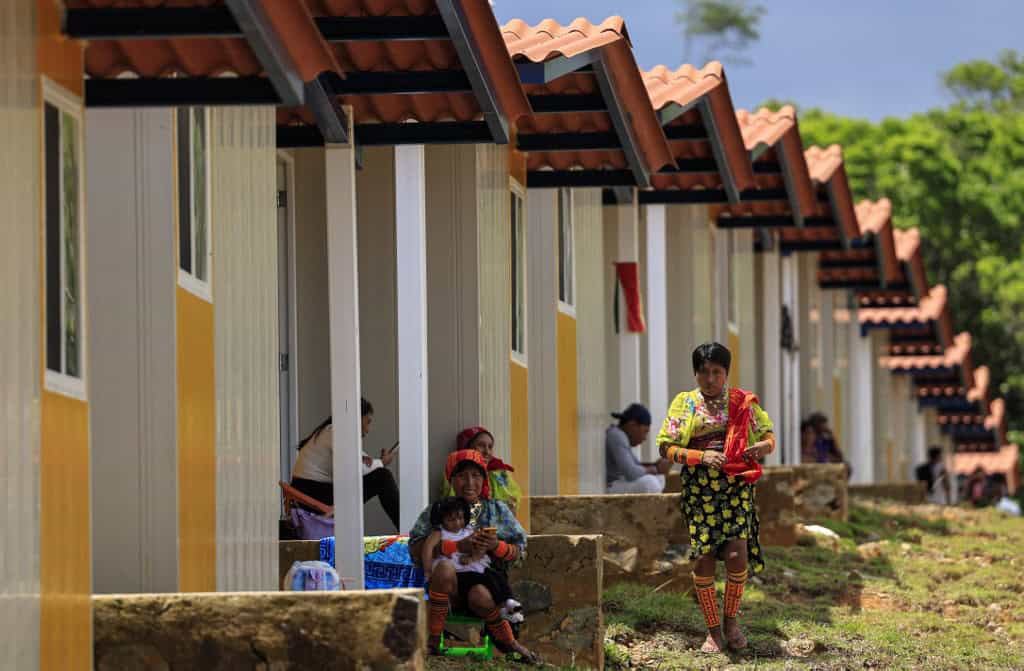A community of indigenous people from Panama received houses from the government on Wednesday where they will live on the mainland, leaving behind, with both nostalgia and hope, their small island in danger of being swallowed by the sea due to climate change. “I’m excited. The houses are beautiful, they are small, but very comfortable,” says Vidalma Yánez, 57, in front of what will be her new home.
The Panamanian government built the Nuevo Cartí development, in the Guna Yala indigenous region, facing the Caribbean, to relocate about 1,200 inhabitants of Cartí Sugdupu, a tiny island threatened with disappearance under the waters due to rising sea levels.
“The climate crisis that the world is experiencing (…) has forced us here in Panama to move the island to this development of around 300 houses,” said President Laurentino Cortizo, as he handed the keys to the first of the benefiting families.
The residents will start moving from June 3 to 6 from their island, about 15 minutes away by boat. They are the first climate change displaced people in Panama, according to the government.
The indigenous people have lived in overcrowded conditions without basic services in Cartí Sugdupu, an island the size of five football fields where houses have dirt floors, and walls and roofs made of cane, wood, and zinc sheets.
It is one of the 365 islands of the Guna Yala archipelago, several of which are at risk of flooding. The 49 inhabited islands are only between 50 cm and one meter above sea level.
“There are other Panamanian islands that are also in a vulnerable situation,” Cortizo warned, blaming developed countries for global warming. Cortizo personally handed over a hundred keys, but by the end of the event, all keys were in the hands of their new owners, according to the government.
Life change
Nuevo Cartí (‘Isber Yala’, loquat tree in the indigenous language) was built with a state investment of 12.2 million dollars, on 14 hectares of land belonging to the community that is relocating.
“The way of living is going to change a lot; people on the island are used to a different life,” says Yánez, dressed in the colorful attire of the Guna ethnic group. In Cartí Sugdupu, they live off fishing, tourism, and the production of yucca and plantains, which they grow in the continental area.
What motivates them the most is leaving the overcrowded island. “I’m excited, I like the house, just need to bring things here,” says Marialis López, 26.
She will move to the mainland with her three young children and two brothers. She is excited about decorating the house nicely and planting “little flowers.”
“It can change my life here,” she says. “Over there in my house, we are all together (overcrowded),” she explains, noting that her new home has two bedrooms.
On Cartí Sugdupu, the islanders lack potable water, and most do not have continuous electricity. The bathrooms are communal cubicles on the docks where wooden planks over the sea serve as toilets.
Nostalgia for the sea
In Nuevo Cartí, the indigenous people will live in houses of 40.96 m2. Although small, they have two bedrooms, a living room, dining room, kitchen, bathroom, and laundry, as well as water and electricity.
But each house has a plot of 300 m2, useful for planting. “It will be a bit hard because we no longer have the sea so close to fish, but different ‘businesses’ will come in,” Yánez says.
Additionally, several houses are adapted for people with disabilities, and there are facilities related to the Guna ethnic culture. “It’s a moment of joy, I’m happy because we are coming to live here in the neighborhood,” says Anel Franklyn, 33.
“Here we would have electricity 24 hours a day, we have the bathroom inside, which is much better for us, and potable water,” he adds. Franklyn, who will live with his wife and five children, says he earns a living by going to the mainland to work on plantain plantations. Now he will not have to rely on a cayuco (canoe) to get from the island.
Nostalgically, he says that “over there it’s all sea.” But he immediately says optimistically: “Here it’s all forest where children can run and do more things.”






